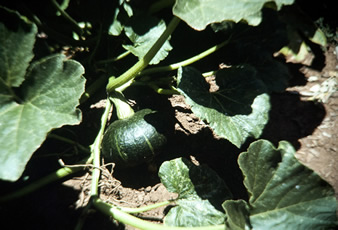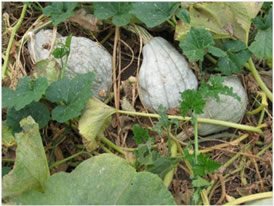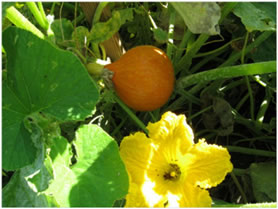Winter Squash
The CUCURBITACEAE family has many forms and has been feeding the world since the beginning of recorded history. The remains of cucumbers and gourds have been found in archaeological excavations dating two centuries before Christ. Members of this family have origins in many different regions of the world. Only the cucurbita genus is thought to originate in North, Central and South America.

Squashes belong to the Cucurbitaceae family along with the melons, cucumbers, gourds and pumpkins. They are also divided into short and long maturities. The genera Citrullus and Cucumis include watermelons, cantaloupe and cucumbers. The genus Cucurbita includes winter and summer squash and some gourds, while the chayote is a Sechium and sponge gourd is a Luffa. In the Genus Cucurbita there are six species of squash, three of which we will deal with here:
- C. maxima includes banana, hubbard, marrow, and turban squash, and some European pumpkins.
- C. moschata includes all the butternuts, cheese and the melon squash or Tahitian.
- C. mixta includes Southwest Indian varieties, cushaws, except Golden cushaw which is a C. moschata.
Different varieties within an individual species will cross-pollinate but there is no crossing between varieties of different species. Remember that when a cross occurs you cannot see the change in that summer's fruit, but it will show up if you save the seed and plant it the next year.

WINTER SQUASH are mostly vining types, with fruit that is dryer and richer in flavor than summer varieties. Although called winter squash the seed is planted after the soil has warmed in the spring but harvested as much as 2 months later than the summer type. Popular varieties are banana, butternut, buttercup, acorn, delicata, hubbard and Tahitian. Some plants are dwarf and some plants grow four feet square.
Plants can be seeded in containers to get an early start. Plant under floating row cover fabric (like Reemay) or clear plastic tunnels. You can direct seed in garden soil after night temperatures are above 55 degrees. Prepare a 4 foot diameter basin, mix in one wheelbarrow-full of composted manure or half steer and half compost mixed with the soil from the hole. Settle soil with a good watering. Plant 4-6 seeds a few inches apart, and keep the two strongest plants. Mulch when plants have 5 leaves.
After a few fruit have set, pinch off the fuzzy ends of the vines. Harvest after maturity date has been reached (depends on variety). When harvesting, leave a 2-inch stem on the fruit - handle with care so as not to bruise. Cure a week or two in a warm, well-ventilated place before storage.

Also check out ...
UC websites for the Vegetable Research and Information Center (http://vric.ucdavis.edu) and Integrated Pest Management (www.IPM.ucdavis.edu)
Planting Dates
Coastal:
April to June
Inland:
April to June

